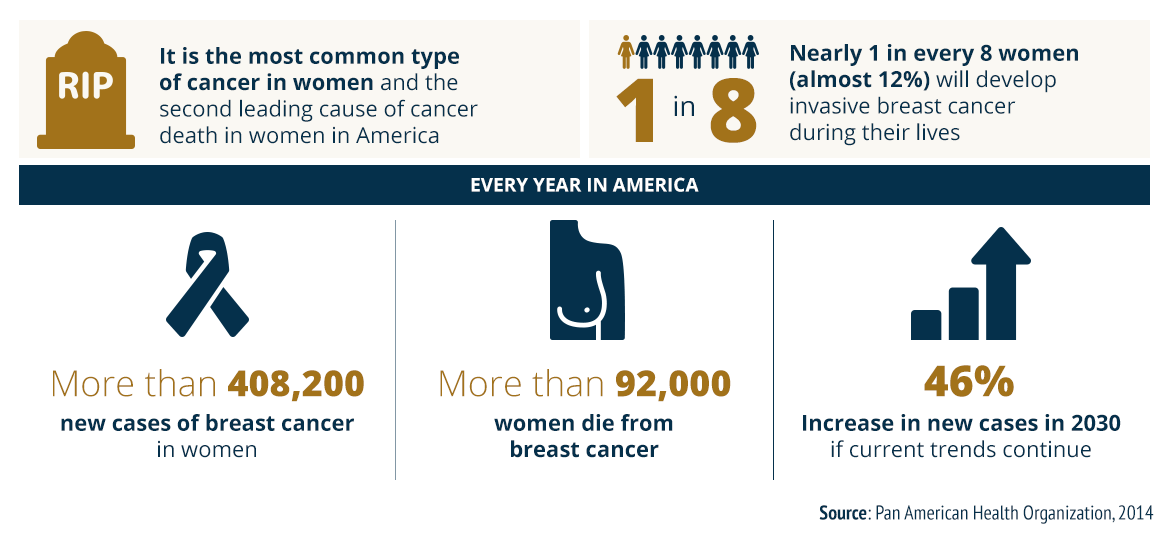31 Oct 2017
Ladies, the Numbers Speak for Themselves
More than 12% of American women will suffer from invasive breast cancer at some point in their lives. The American Cancer Society estimates that there will be over 250,000 cases in the United States alone, and the probability of being diagnosed at an advanced stage of the cancer is higher for Hispanic women. The numbers are bone-chilling. So the questions becomes, can we prevent breast cancer?
The risk factors
Every woman wants to know what she should do to reduce her risk of breast cancer. The best way to address this question is to start by getting a better understanding of this specific kind of cancer and its major risk factors.
Being female puts you at the highest risk, although that’s not very helpful since a sex change is hardly a realistic solution. We know that approximately 50% of diagnosed cases are linked to hormonal factors.
Genetic inheritance is another example of a risk factor that can’t be controlled—at least not yet. However, it is interesting to note that only 5 to 10% of cases can be traced back to abnormal genes passed on from parents to children.
Genes are short sections of DNA found in chromosomes. DNA contains all the instructions necessary to build the proteins that determine the structure and function of every cell in your body. Any abnormal change to the DNA of a gene can lead to defects in cell growth and functions. These defects can then be present in every cell that contains the gene.
Most hereditary cases of breast cancer are linked to mutations in two genes: the BRCA1 and BRCA2 (the name of the gene comes from BReast CAncer). When expressed normally, the BRCA1 gene provides the instructions to produce a protein that acts as a tumor suppressor. These proteins help to stop cells from growing and dividing too quickly or uncontrollably.
That said, the majority of people who develop breast cancer do not inherit a gene mutation and do not have a family history of the disease. Nevertheless, women who have blood relatives (grandmothers, mothers, sisters, aunts) who have been diagnosed with breast cancer before the age of 50 are at a higher risk.
Age is another physiological, non-hormonal risk factor (as much as we may try to hide it.) Advancing age puts us at risk for several illnesses, including breast cancer, because the longer we live, the more opportunities there are for genetic mutations in the body. And as we get older, our bodies are less equipped to repair genetic damage. According to the American Cancer Society, approximately one in every eight cases of invasive breast cancer develop in women under the age of 45, and approximately two in every three cases are found in women older than 55.
Certain lifestyle choices and environmental factors can also increase the risk for breast cancer—among them smoking, drinking alcohol, being overweight, and leading a sedentary life or not exercising. Obese women are at a higher risk for breast cancer compared to women who maintain a healthy weight, especially after menopause. Being overweight can also increase the chances that breast cancer will recur in women who have already had the disease.
Recent studies showed a possible link between vitamin D deficiency and increased risks of breast cancer. Vitamin D could play an important role in the healthy development of breast tissue and may be able to halt the growth of breast cancer cells, according to the National Cancer Institute.
So...can breast cancer be prevented?
We mentioned that certain risk factors, such as gender, age, and genetic inheritance, can’t be altered just yet. But it is worth noting that breast cancer cases have been declining steadily in the past 30 years, largely due to preventive studies, better diets, and healthy lifestyle choices (such as quitting smoking.)
Survival rates for breast cancer vary from country to country, but they are generally improving. This is partly because breast cancer can now be diagnosed in its early stages, at least in women who live in parts of the world where they have good access to healthcare. Another reason why death rates are lower is the increasing availability of better treatment options. In many countries with advanced healthcare, survival rates for breast cancer cases diagnosed in their initial stages are between 80 and 90%, dropping to 24% for cases diagnosed in later stages.
With these numbers in mind, we can conclude that mammograms are the most valuable and effective tool to help prevent deaths from breast cancer, even if there is an ongoing debate about when and how frequently to get them. Making certain lifestyle changes is another important preventive measure, and one that is in the hands of women as well as the entire family:
- Maintaining a healthy weight
- Exercising regularly (at least 4 hours a week)
- Sleeping well
- Avoiding alcohol, or limiting alcohol consumption (beer, wine, liquor) to one drink per day
- Not smoking
- If possible, breastfeeding your babies.
Still haven’t gotten your mammogram? Make an appointment ASAP.
Sources: http://www.breastcancer.org/ ; National Cancer institute (NIH) ; Genetics Home Reference ; American Cancer Society ; HolaDoctor.com



